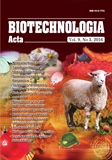ISSN 2410-7751 (Print)
ISSN 2410-776X (Online)

"Biotechnologia Acta" V. 9, No 3, 2016
https://doi.org/10.15407/biotech9.03.069
Р. 69-75, Bibliography 19, English
Universal Decimal Classification: 576.32/.36:[611.018.21][615.375]:616-006.
O. V. Skachkova 1, N. M. Khranovska 1, L. M. Skivka 2, P. I. Sydor 1, M. V. Inomistova 1, T. S. Vitryk 1
1 National Cancer Institute of Ministry of Health of Ukraine, Kyiv
2 Kyiv Taras Shevchenko National University, Ukraine
The aim of the research was to examine the effect of Staphylococcus aureus Wood 46 cytoplasmic membranes extract on the maturation and functional activity of generated in vitro dendritic cells from monocytes in the peripheral blood of healthy patients and patients with malignancies. Found that the cytoplasmic membranes extract in the minimal of the studied concentrations (0.2 mg/ml) promoted the increased reliable expression of CD86 and HLA-DR molecules and of mRNA of cytokines ІFN-γ and TNF-α, and CC chemokine generated from CCR7 in dendritic cells. The results showed that the cytoplasmic membranes extract contributed to T1-helper polarization of dendritic cells and can be used to generate them in the dendritic cell vaccines production for cancer patients immunotherapy.
Key words: dendritic cell, cytoplasmic membranes extract, dendritic cell vaccines.
© Palladin Institute of Biochemistry of the National Academy of Sciences of Ukraine, 2016
References
1 Banchereau J., Steinman R. M. Dendritic cells and control of immunity. Nature. 1998, N 392, P. 245–252. https://doi.org/10.1038/32588
2 Coventry B. J., Ashdown M. L. Complete clinical responses to cancer therapy caused by multiple divergent approaches: a repeating theme lost in translation. Cancer Manag. Res. 2012, N 4, P. 137–149. https://doi.org/10.2147/CMAR.S31887
3 Silva R., Castro М., Pereira V. Dendritic cell-based approaches in the fight against diseases. Front. Immunol. 2014, N 5, P. 1–4. https://doi.org/10.3389/fimmu.2014.00078
4 Scott J. R., Barnett T. C. Surface proteins of gram-positive bacteria and how they get there. Annu. Rev. Microbiol. 2006, N 60, P. 397–423. https://doi.org/10.1146/annurev.micro.60.080805.142256
5 Shahrooei M., Hira V., Khodaparast L., Khodaparast L., Stijlemans B., Kuchar?kov? S., Burghout P., Hermans P. W. M., Elderea J. V. Vaccination with SesC decreases Staphylococcus epidermidis biofilm formation. Infect. Immunol. 2012, 80 (10), 3660–3668. https://doi.org/10.1128/IAI.00104-12
6 P?rez-Dorado I., Galan-Bartual S., Hermosov J. A. Pneumococcal surface proteins: when the whole is greater than the sum of its parts. Mol. Oral. Microbiol. 2012, 27 (4), 221–245. doi: 10.1111/j.2041-1014.2012.00655.
7 Ryu Y., Baik J., Yang J., Kang S., Im J., Yun C., Kim D., Lee K., Chung D., Ju H., Han S. Differential immunostimulatory effects of Gram-positive bacteria due to their lipoteichoic acids. Int. Immunopharmacol. 2009, 9 (1), 127–133. doi: 10.1016/j.intimp.2008.
8 Sabado R., Bhardwaj N. Cancer immunotherapy: dendritic-cell vaccines on the move. Nature. 2015, 19 (519), 300–301. https://doi.org/10.1038/nature14211
9 Anguille S., Smits E., Bryant C., Van Acker H., Goossens H., Lion E., Fromm P., Hart D., Van Tendeloo V., Berneman Z. Dendritic Cells as Pharmacological Tools for Cancer Immunotherapy. Pharmacol. Rev. 2015, 67 (4), https://doi.org/10.1124/pr.114.009456
10 Hashimoto M., Tawaratsumida K., Kariya H., Kiyohara A., Suda Y., Krikae F., Kirikae T., G?tz F. Not lipoteichoic acid but lipoproteins appear to be the dominant immunobiologically active compounds in Staphylococcus aureus. J. Immunol. 2006, 177 (5), 3162–3169. https://doi.org/10.4049/jimmunol.177.5.3162
11 Skivka L. M., Shevts Yu. V., Khranovskaya N. M., Fedorchuk O. G., Pozur V. V., Senchilo N. V. Synergistic effect of microbe-associated molecules on human monocyte-derived dendritic cell maturation in vitro. Biopolymers & Cell. 2012, N 1, P. 50–55. dx.doi.org/10.7124/bc00002C. (In Ukrainian).
12 Anguille S., Smits E. L., Lion E., van Tendeloo V., Berneman Z. Clinical use of dendritic cells for cancer therapy. Lancet Oncol. 2014, N 15, P. e257–267. https://doi.org/10.1016/S1470-2045(13)70585-0
13 Talaev V. Yu., Plehanov M. V. Study migration of dendritic cells and antigens of traffic in order to improve the means of immunization. Medial. 2014, 2 (12), 1–18. (In Russian).
14 Oth T., Vanderlocht J., Van Elssen C. H. M. J., Bos G. M. J., Germeraad W. T. V. Pathogen-associated molecular patterns induced crosstalk between dendritic cells, t helper cells, and natural killer helper cells can improve dendritic cell vaccination. Mediat. Inflammat. 2016, Article ID 5740373, 12 p. https://doi.org/10.1155/2016/5740373
15 O'Shea J. J., We P. Mechanisms underlying lineage commitment and plasticity of helper CD4+ T cells. Science. 2010, 26 (327), 1098–1102. https://doi.org/10.1126/science.1178334
16 Alvarez D., Vollmann E. H., von Andrian U. H. Mechanisms and Consequences of Dendritic Cell Migration. Immunity. 2008, 29 (3), 325–328. https://doi.org/10.1016/j.immuni.2008.08.006
17 Pletinckx K., Stijlemans B., Pavlovic V., Laube R., Brandl C., Kneitz S., Beschin A., De Baetselier P., Lutz M. B. Similar inflammatory DC maturation signatures induced by TNF or Trypanosoma brucei antigens instruct default Th2-cell responses. Eur. J. Immunol. 2011, N 41, P. 3479–3494. https://doi.org/10.1002/eji.201141631
18 Tuyaerts S. Dendritic cell therapy for oncology roundtable conference. J. Immune Based Ther. Vaccines. 2011, 9 (1), 10 p. https://doi.org/10.15789/1563-0625-2010-3-199-206
19 Chernykh E. R., Leplina O. Y., Tyrinova T. V., Tikhonova M. A., Stupak V. V., Mishinov S. V., Pendyurin I. V., Ostanin A. A. Anti-tumor activity of dendritic cells in healthy donors and patients with brain tumors. Medical Immunology. 2010, 12 (3), 199–206. https://doi.org/10.15789/1563-0625-2010-3-199-206

